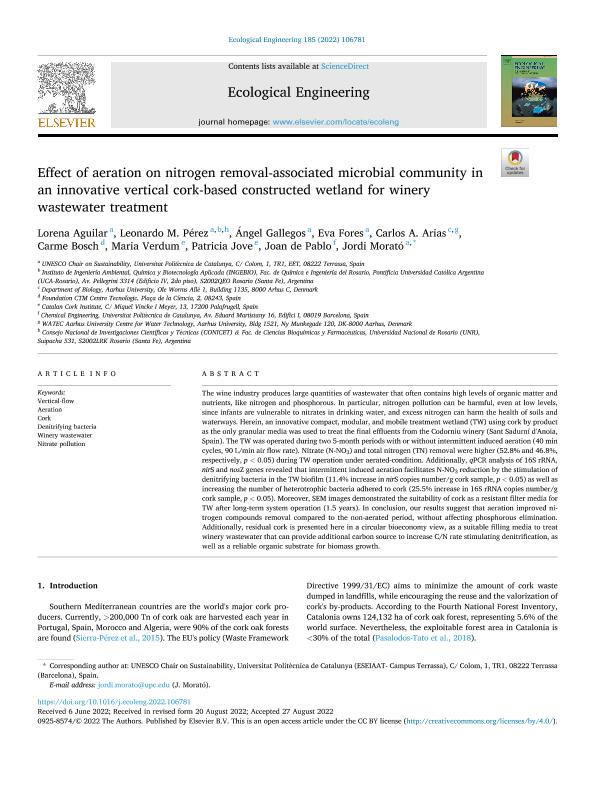Artículo
Effect of aeration on nitrogen removal-associated microbial community in an innovative vertical cork-based constructed wetland for winery wastewater treatment
Aguilar, Lorena; Perez, Leonardo Martin ; Gallegos, Ángel; Fores, Eva; Arias, Carlos A.; Bosch, Carme; Verdum, Maria; Jove, Patricia; de Pablo, Joan; Morató, Jordi
; Gallegos, Ángel; Fores, Eva; Arias, Carlos A.; Bosch, Carme; Verdum, Maria; Jove, Patricia; de Pablo, Joan; Morató, Jordi
 ; Gallegos, Ángel; Fores, Eva; Arias, Carlos A.; Bosch, Carme; Verdum, Maria; Jove, Patricia; de Pablo, Joan; Morató, Jordi
; Gallegos, Ángel; Fores, Eva; Arias, Carlos A.; Bosch, Carme; Verdum, Maria; Jove, Patricia; de Pablo, Joan; Morató, Jordi
Fecha de publicación:
12/2022
Editorial:
Elsevier Science
Revista:
Ecological Engineering
ISSN:
0925-8574
Idioma:
Inglés
Tipo de recurso:
Artículo publicado
Clasificación temática:
Resumen
The wine industry produces large quantities of wastewater that often contains high levels of organic matter and nutrients, like nitrogen and phosphorous. In particular, nitrogen pollution can be harmful, even at low levels, since infants are vulnerable to nitrates in drinking water, and excess nitrogen can harm the health of soils and waterways. Herein, an innovative compact, modular, and mobile treatment wetland (TW) using cork by product as the only granular media was used to treat the final effluents from the Codorniu winery (Sant Sadurní d'Anoia, Spain). The TW was operated during two 5-month periods with or without intermittent induced aeration (40 min cycles, 90 L/min air flow rate). Nitrate (N-NO3) and total nitrogen (TN) removal were higher (52.8% and 46.8%, respectively, p < 0.05) during TW operation under aerated-condition. Additionally, qPCR analysis of 16S rRNA, nirS and nosZ genes revealed that intermittent induced aeration facilitates N-NO3 reduction by the stimulation of denitrifying bacteria in the TW biofilm (11.4% increase in nirS copies number/g cork sample, p < 0.05) as well as increasing the number of heterotrophic bacteria adhered to cork (25.5% increase in 16S rRNA copies number/g cork sample, p < 0.05). Moreover, SEM images demonstrated the suitability of cork as a resistant filter media for TW after long-term system operation (1.5 years). In conclusion, our results suggest that aeration improved nitrogen compounds removal compared to the non-aerated period, without affecting phosphorous elimination. Additionally, residual cork is presented here in a circular bioeconomy view, as a suitable filling media to treat winery wastewater that can provide additional carbon source to increase C/N rate stimulating denitrification, as well as a reliable organic substrate for biomass growth.
Archivos asociados
Licencia
Identificadores
Colecciones
Articulos(CCT - ROSARIO)
Articulos de CTRO.CIENTIFICO TECNOL.CONICET - ROSARIO
Articulos de CTRO.CIENTIFICO TECNOL.CONICET - ROSARIO
Citación
Aguilar, Lorena; Perez, Leonardo Martin; Gallegos, Ángel; Fores, Eva; Arias, Carlos A.; et al.; Effect of aeration on nitrogen removal-associated microbial community in an innovative vertical cork-based constructed wetland for winery wastewater treatment; Elsevier Science; Ecological Engineering; 185; 12-2022; 1-7
Compartir
Altmétricas



